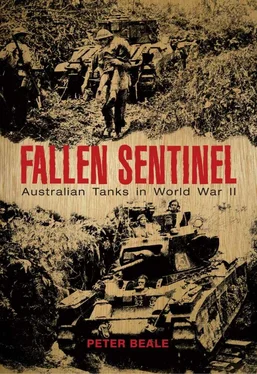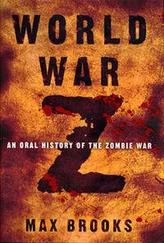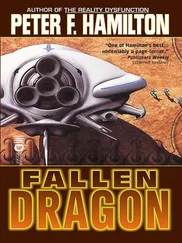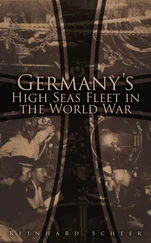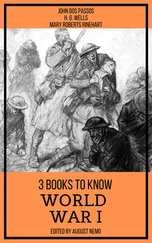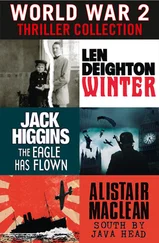The primer’s approach to operations is prefaced by the statement that ‘it is not intended to lay down details of the employment of armoured brigades, since these can be worked out only in actual practice, but rather to indicate the general principles which should be followed. The main principle is that ground is of primary importance and open country is the country suitable for armoured forces whereas enclosed country is favourable to infantry.’ The primer adds that, in good tank country◦— described as open and undulating ground◦— antitank weapons ‘should be rapidly neutralised and then destroyed by a well coordinated and energetic attack by an armoured brigade.’ This is portrayed as a relatively simple task.
The primer moves on to discuss offensive operations, focusing principally on the armoured brigade in an independent attack. The objectives suitable for an armoured brigade acting independently are listed as: hostile cavalry formations; hostile infantry formations; lines of communication; and hostile armoured formations. Adds the handbook, ‘such formations do not exist at the moment [in 1929] and because the subject is therefore purely theoretical it will not be further discussed.’ A later section considers the attack in cooperation with other arms and offers the advice that: ‘in allotting tasks to formations, the Commander will bear in mind the special characteristics of each arm and use the ground accordingly.’
The information provided in this pamphlet is so general as to be of little value. It is unfortunate that this is the best set of conclusions that could have been drawn from the exercises of the Experimental Force in 1927 and 1928. Broad also commented in his conclusion on the sort of people who should be employed as armoured soldiers: ‘Morale depends mainly on the confidence a man has in his weapons. A good education is therefore essential if full use is to be made of tanks and their armament.’
The success of armoured formations would also depend to a greater extent on the technical knowledge of the various commanders from the highest to the lowest. That is to say, unless officers were fully competent mechanically, they would not be able to get the best out of their machines, to judge their limitations, to keep them in action, to prepare them again quickly for renewed effort, or to recommend technical improvements to those whose work it was constantly to improve design. These precepts would certainly have been of great value had they been learnt and executed by those who soldiered in armoured formations from that time on.
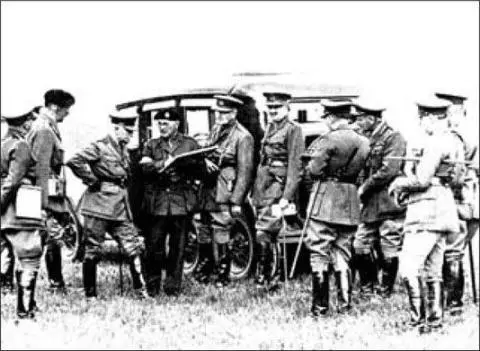
Salisbury Plain, 1931. Charles Broad (in beret, holding map board), explaining the purpose of an exercise to the CIGS, Sir George Milne. Broad was able to demonstrate the control of a brigade of tanks by radio, maintaining formation while passing through a dense fog (Tank Museum image).
The Purple Primer was updated in 1931 and republished as Modern Formations. 24While this second publication did include a little more discussion on the use of armour with other arms, once again, it was not specific enough to provide guidance for those who would actually have to fight with such formations.
In 1931 a tank brigade was established as an experimental formation with Broad in command, and exercises were conducted to determine an effective means of command using radio. The exercises were completed within a fortnight. The tank brigade staged a display of movement in formation which was controlled by Broad’s voice on the radio. His words were clearly received in the battalion and company commanders’ vehicles and the brigade was able to sustain formation even when passing through dense fog.
In February 1933, Sir George Milne retired as CIGS after seven years. He was succeeded by Sir Archibald Montgomery-Massingberd, who had served in the First World War as Chief of Staff to the Commander of the Fourth Army. 25Montgomery-Massingberd (frequently referred to as MM) was later given a particularly bad press by military writers such as Basil Liddell Hart. MM was, in some ways, a traditionalist, but as many of his actions and writings demonstrate, he did his best to modernise the British Army.
In autumn 1933, MM established the tank brigade as a permanent formation and gave command to Percy Hobart. Hobart subsequently held discussions with Lindsay on the tank brigade’s relationship with various other formations. On 17 November 1933 Lindsay wrote to Hobart and suggested that the tank brigade be incorporated into a mobile division which would consist of the tank brigade, the motorised cavalry brigade, the motorised infantry brigade, mechanised artillery and supporting forces.
This was simply an idea at this stage and neither Lindsay nor Hobart had the authority to create a mobile division. However, in January 1934, MM issued a directive for the training of the tank brigade. The directive suggested that the tank brigade could be employed on a strategic or semi-independent mission against some important objective in the enemy’s rearward organisation, avoiding strength and attacking weak points. The directive for the training outlined its main objectives, which were to ‘test the manoeuvrability of the brigade as a whole, to practise co-operation with the RAF, to try out methods of supply and maintenance, and aim at moving 70 miles a day or 150 miles in 3 days including an action in each case.’ 26
In spring 1934, the tank brigade assembled on Salisbury Plain. In May, a staff exercise was conducted to develop the techniques to be used in the deployments envisaged in the exercises. In preliminary manoeuvres, Hobart routinely insisted on a very widely spaced formation for his brigade, covering an area ten miles broad by ten miles deep. The opposing forces were generally unmechanised and were invariably defeated. This imbalance was to be reduced in the main exercises scheduled for November in which the opposing force would be somewhat stronger, although still a conventional force. The experimental force would comprise a tank brigade plus the 7th Infantry Brigade with a motorised field artillery brigade and other supporting units to form a small mechanised division known as the Mobile Force under the command of Lindsay. Opposing it would be a traditional force consisting of an unmechanised infantry division, a horsed cavalry brigade and two armoured car units. This force was commanded by Major General John Kennedy.
The Director of the exercise was John Burnett-Stuart, who was then General Officer Commanding (GOC) Southern Command. The GOC considered that the older arms, infantry and cavalry, needed a boost to their morale because of the way that they had been consistently out-manoeuvred by the mechanised forces. He therefore made the exercise particularly demanding for the mechanised forces. The result of the exercise was a win for the conventional forces, primarily because Lindsay was unwell at the time of the exercise; the opposing force was effectively commanded by Kennedy; and the umpiring throughout the exercise appeared to favour the traditional force.
While the outcome of this exercise was disappointing for the mechanised forces, its positive aspect was that, following its completion, MM decided to form a mobile division to replace the horsed cavalry division. The next year he issued a policy paper entitled ‘The future re-organisation of the British Army’. He resigned as CIGS around six months later and wrote what he called ‘Handing Over Notes’ for the guidance of his successor, Sir Cyril Deverell. 27These notes described the current problems of the British Army, including a number related to tanks. On tanks, MM wrote that intervention with the field army on the continent would be essential if a war were to break out with a continental power (the continental power was clearly Germany). He added that the field force, which could be sent to the continent and be ready to disembark overseas within a fortnight, was to consist of the mobile division, four infantry divisions and two air defence brigades. The infantry divisions were to be supported by one infantry tank battalion for each division. He also recommended that eight regiments of cavalry be mechanised, one in 1936 and the remainder by the end of 1938. Thus, his policies for the organisation and establishment of armoured forces were determined at the time of his resignation in April 1936.
Читать дальше
